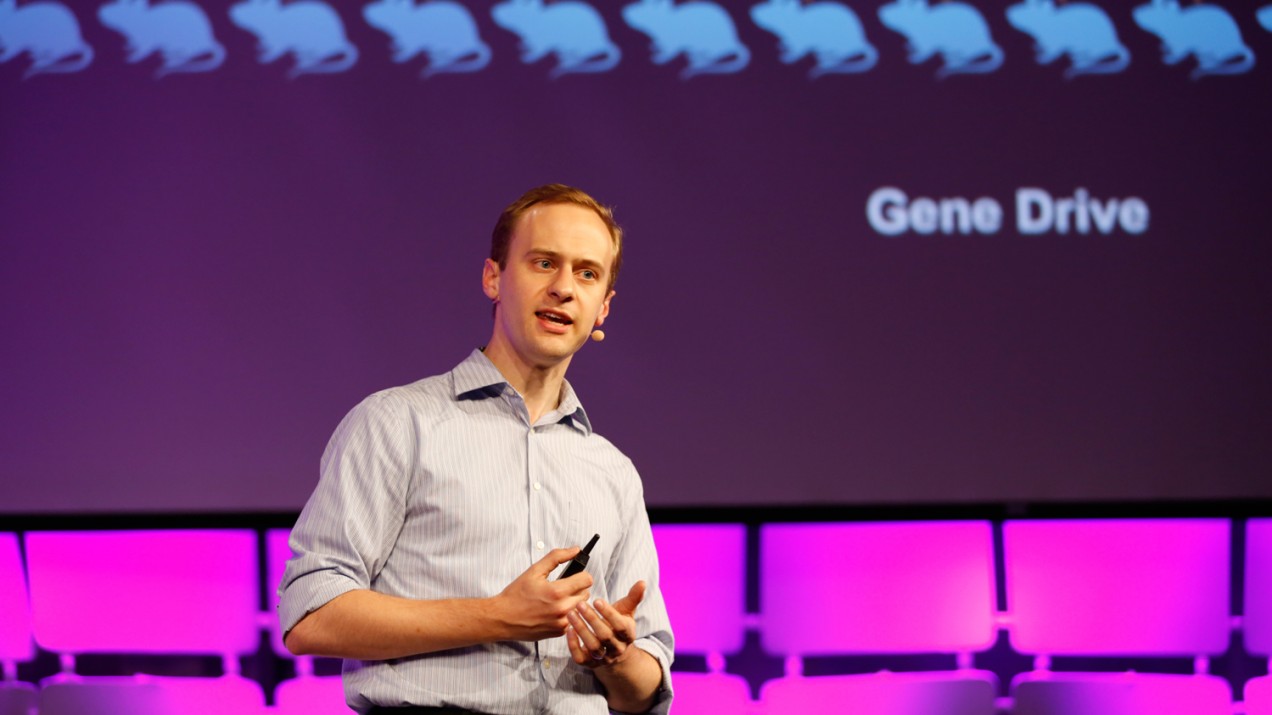

Rewriting Life
Stop “Gene Spills” Before They Happen
Proposal would use gene-editing patents to force scientists to open their labs to scrutiny.

An MIT biology professor says he plans to use patents in an unusual way: to push gene-editing scientists out into the open.
Kevin Esvelt has helped develop a technology called “gene drive,” an evolution-warping technique that could be used to wipe out malaria-causing mosquitoes or invasive species like rats on Pacific islands.
Gene drives use the DNA-slicing technology called CRISPR to force a “selfish” gene to spread in wild populations of animals as they reproduce. Speaking at EmTech MIT 2016 on Wednesday, Esvelt said he’s worried about an ecological accident—or simply premature use of the technology.
Now he’s proposing the unprecedented step of using patents to require university scientists to disclose their intentions before they carry out any experiments.
“It’s essential we don’t develop ecological technologies behind closed doors,” says Esvelt. “We need a space to discuss what is going on in laboratories and what they are planning.”
In the U.S., academic scientists are able to mostly ignore patents. That’s because it is a tradition not to enforce intellectual-property claims on basic researchers. However, the law says that a patent holder can stop anyone from making or using a technology.
Esvelt says he wants to test the law. His demand: be 100 percent open or work on something else.
I asked Jacob Sherkow, a law professor at New York Law School, if the plan could work. “The short answer is yes, you can require licensees of a patent to conduct themselves in the way you would like,” he says. “Although he might have to sue people to take a license and comply with him.”
Esvelt likens his initiative to “copyleft,” a way some software developers, instead of trying to make money, use their copyright to make sure their code stays open-source. He says he would also require labs to follow safety procedures that he and other scientists agreed on in 2015 to prevent gene-drive creations from escaping.
Esvelt might have the clout to make it happen. He is a coauthor on a gene-drive patent application filed by Harvard University. He says he is also talking to lawyers at Harvard and MIT about using those schools’ basic patents on CRISPR gene editing to enforce his openness plan.
“Some scientists might not like being so open, but most say ‘Okay, so long as everyone else is too,” says Esvelt. Biologists can be highly secretive, but it’s often because they are afraid of being scooped.
There’s already a precedent for using patents to limit the spread of gene-drive technology. In September, Monsanto purchased a license to CRISPR patents from the Broad Institute of MIT and Harvard in order to genetically engineer new plants. But that license came with an extraordinary proviso: Monsanto was “prohibited” from developing a gene drive. The Broad Institute noted, in a statement explaining the restrictions, that gene drives have “the potential to disrupt ecosystems.”
Esvelt first worked out the idea for a CRISPR gene drive in 2014 and filed his patent. He did his work mostly on paper. But his fears of risky lab work were realized a few months later when a lab in California arrived at the idea independently and used it to turn black fruit flies yellow, implementing less than perfect safety controls.
What if one of the flies had escaped? “My nightmare is a wave of yellow flies spreading across the country,” says Esvelt. He imagines a corresponding wave of negative media coverage and loss of trust in scientists.
Esvelt is working on his own long-range plan to create a gene drive in white-footed mice to fight Lyme disease in the eastern U.S. It would work by spreading genes that makes mice resistant to Lyme.
Before doing any lab work, he published his designs and held meetings on Nantucket and Martha’s Vineyard, two islands where he hopes to test the idea.